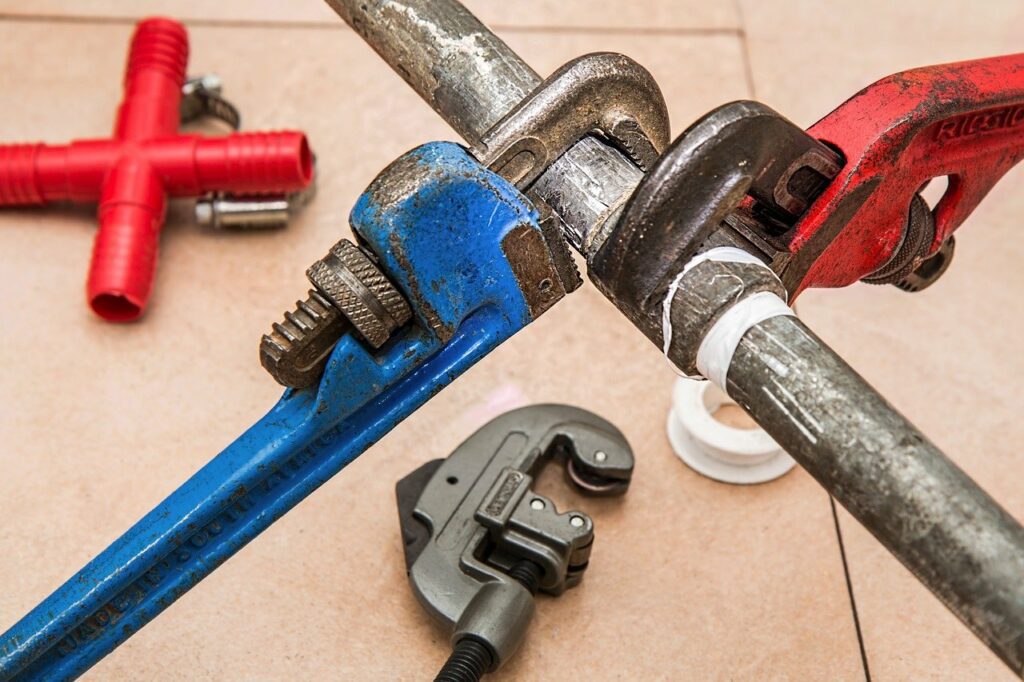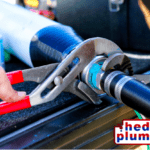Leaks aren’t just a problem that plagues homeowners in movies; they’re something that could happen to anyone across the world because water damage is always a possibility when you have a home with plumbing. The best way to avoid this issue is by having more knowledge about your pipes and how they work, which will let you know precisely where to look for leaks before things can get out of hand because nobody wants more water damage on their hands.
As most homeowners know, water leaks are never good. They end up costing money and wasting resources that can be put to better use elsewhere. One of the first steps to take when you notice leaks is to figure out whether you need a plumber or if it’s something you can fix on your own. After all, no one wants to call a plumber for every miscellaneous problem that comes up.
How to Tell Your Plumber from Your DIY Skills
Sometimes you can tell right away if it’s something you need to call the plumbers about, but other times it might not be easy. Here are some tips on differentiating between your average household water leaks and those best suited for professionals.
- Is It Inside or Outside?
If your water leak is visible on the inside of your house, it’s probably just an issue with the plumbing inside of your home. However, visible outside of your home means there may be a more significant issue at play, such as flooding due to clogged gutters or inadequate drainage in cases where it’s been raining.
- When Does the Leak Happen?
Your water leak may also be a sign of more significant issues if it starts happening more frequently, such as leaks that occur more often on rainy days or during specific seasons. It could mean you have a drainage issue outside, which you should bring up to your plumber right away for them to fix before it creates further damage.
- What Is the Water Source?
Another way to assess whether your water leak is something best left to the professionals is by identifying where the leak is coming from and what type of line it’s located in. In some cases, this step alone might let you know it’s time to call your plumber because common causes of leaks inside include burst pipes or issues with toilets or sinks.
- Is It Visible?
If you can see water coming out of a hole, crack, or tear in your ceiling, it’s likely the result of a burst pipe. However, suppose the leak is in an area where water isn’t typically visible based on your habits. In that case, you probably have a more significant drainage issue that only your plumber will be able to handle.
- Why Did This Leak Start?
Another aspect to consider before calling for help is when this particular leak started happening. Suppose it occurred overnight when no one was around, but water damage has been present all day long. In that case, you might have more extensive problems creating new leaks over time rather than just one incident requiring immediate attention.
The good news is that in most cases, leaks only need to be addressed when they’re happening, so there’s no real danger of letting a leak go untreated for too long. If you know what to look out for and what type of water leak it is, you can usually determine whether or not it requires professional help.
However, if you’re not sure what to look out for or how extensive the damage might be, then it’s always better to err on the side of caution and get a plumber over as soon as possible.
Areas of Concern
Appliance Leaks: Appliances are something that most homeowners take for granted, but they can cause severe water damage if they leak during use. Most household appliances aren’t known for their reliability, so you’ll want to look out for signs of leakage with dishwashers, washing machines, and other types of appliances. This is the easiest type of water leak to identify because it’s usually accompanied by a visible trail of water around the appliance itself, so you’ll want to catch this issue as soon as possible before your flooring starts getting damaged.
Water Main Breaks: In some cases, when a pipe snaps or pressure builds up due to high demand, water service might get cut off in some regions of your home while your plumber works on fixing the leak. This happens with larger mains that feed into homes from water towers because it’s too difficult to pinpoint exactly where the leak is. It’s not always a major inconvenience, but it requires you to store extra water and boil any tap water before using it if your plumber has to run many tests and flush out the pipe.
Water Main Leaks: You might assume that your main water line inside your house is entirely safe from leaks, but the truth is that these types of pipes are one of the most likely to experience damage due to weather conditions or outside construction. If you notice any signs of wetness on walls or ceilings, you should call a plumber immediately because it means there could be a problem with your water lines, and they need to be fixed before further damage can be caused.
Water Line Leaks: The last type of water line that commonly causes damage to homes is underground lines. These are typically made from PVC piping. They have flexible movement when they need to be adjusted or repaired, but they’re also more susceptible to leakage because they’re buried beneath the earth’s surface. If you can gain access to these lines through a maintenance hole or steam vent, then you should be able to trace the line until you find the point of leakage and repair it accordingly.
Sewer Line Leaks: Another line that can cause water damage if it begins to leak is your sewer line. This part of the plumbing system carries used water out of your home, so any cracks or breaks in this pipe can be hazardous because they could spill sewage into your house. If you see any signs of wetness inside your home, then you should contact a plumber as soon as possible because it means there’s a severe issue with your plumbing that needs to be fixed before further damage occurs.
Drain Line Leaks: These water leaks stem from faulty drain lines caused by several issues such as root intrusion or a collapsed pipe. You would call this a minor leak because it usually only requires repairs to the drain line itself. It’s also something your plumber will have to fix for you because they have special equipment designed to excavate around the pipe and cut out any damage.
Various Types of Water Leaks
Pinhole leaks
Pinhole leaks are caused by a buildup of sediment or corrosion that weakens the pipe wall. In some cases, these types of water leaks will be small enough that you won’t even notice them because they’re not big enough to do any damage. They only cause problems when the rust from the pinholes spreads and causes more serious structural damage to the piping system and thus requires professional help.
Burst pipes
If you leave your faucet running and come back to find a puddle near it, then it’s likely there were one or two burst pipes in your wall if it happened while no one was around. You should try shutting off all other appliances in case there is another more significant leak waiting to happen, but if that’s not possible, then you might want to consider calling for help. This type of leak is severe because it can lead to water damage over time if the pipe isn’t replaced quickly.
Leaks that cause floors to warp
If you notice your walls or flooring warping, then you might be looking at a more significant problem because it’s an indicator that your foundation is starting to crack and collapse under the pressure of water constantly building up inside the walls. This doesn’t just happen with old houses, which means there might be something wrong with your piping system as well if this type of damage appears out of nowhere.
Toilet leaks
If you tend to let the toilet keep running when it’s not in use or otherwise find that your toilet is constantly leaking, then you might be looking at an older problem with your toilet tank parts like flappers, valves, or ballcocks. These issues will never worsen over time because the price of these parts usually only changes due to inflation; however, they can be complex problems for amateurs even with all of our modern technology.
Broken toilet tank parts
If your flapper, valves, or ballcocks are broken, don’t immediately panic because this type of issue is usually minor and easy enough for amateurs to address themselves by replacing the faulty valve-like other broken plumbing appliances. However, always check your owner’s manual before trying anything yourself, just in case there are special precautions you have to take beforehand or after attempting repairs yourself. Some toilets even require specialty tools, so it’s best to call a plumber when dealing with this problem unless you’re experienced in using tools.
Tip: If that’s not the case, then you might have a problem on your hands with the way your toilet is connected to your drain line because it could be causing back-flowing issues. This means water isn’t being drained properly, which will cause mold growth over time, but there are ways around this, like using chemical drain cleaners like sodium hydroxide -NaOH (lye). It doesn’t sound pleasant, but it gets the job done without destroying any of the toilets themselves; however, make sure you always follow manufacturer instructions to the letter when using chemical drain cleaners because they can be dangerous if misused!
Leaking water valves:
Anyone that’s experienced a leak in their home will tell you that it doesn’t matter how big it is; it could be something simple like someone leaving the bathroom faucet on while away or something more severe like burst pipes. It all depends on where the leak is and what caused it to begin with, but these types of problems are more accessible to fix for amateurs than some other issues you might encounter – unless you take care of them in a timely fashion.
Leaks Caused by Aging Pipes:
One of the most common types of pipe leaks occurs when pipes crack over time due to wear and tear. While you might not notice this type of slow-moving leak right away, it could make itself apparent over weeks or even months, depending on how severe the damage is. These types of pipe leaks can cause ceilings and walls to become damaged over time, which is why it’s essential to call a plumber immediately so they can repair or replace your pipes before the problem gets worse.
If your home has suffered from any pipe leak or appliance leak in the past, then you might be wondering which type will require the most attention. The reality is that all kinds of leaks can cause significant damage if they aren’t repaired soon enough, though some may require more immediate attention than others.
Leaks Caused by Tree Roots:
One of the most challenging types of water leaks to fix are those caused by roots that get into your plumbing system. This can be commonly seen in areas where trees are located close to streets because their roots will spread through the ground, looking for sources of moisture like sewer lines that may hold water after heavy rainfall. This type of leak only becomes more severe over time because it means you’ve got more significant issues with clogged gutters or drains than you realized.
Sudden Pipe Leaks:
The last type of water leak you might experience in your home is a sudden pipe leak. These types of leaks are often caused by damage to the outside of your plumbing system, so they’re easy for plumbers to identify and repair. This type of water leak can be commonly seen in homes with old pipes or those located close to roads where there may have been issues with road construction or other types of machinery that could have caused cracks and breaks in your plumbing.
Water shutoff valve
You don’t want to forget about turning off your main water shutoff valve before attempting to repair yourself on any other valves or appliances, so you don’t flood your home instantly! It happens more than we’d like, especially when everyone comes back from vacation, so remember to check now and then.
In Conclusion
Though several types of water leaks, they typically require professional help to be fixed correctly and completely. The faster you can get a plumber out to inspect the problem, the less chance of additional damage over time.




